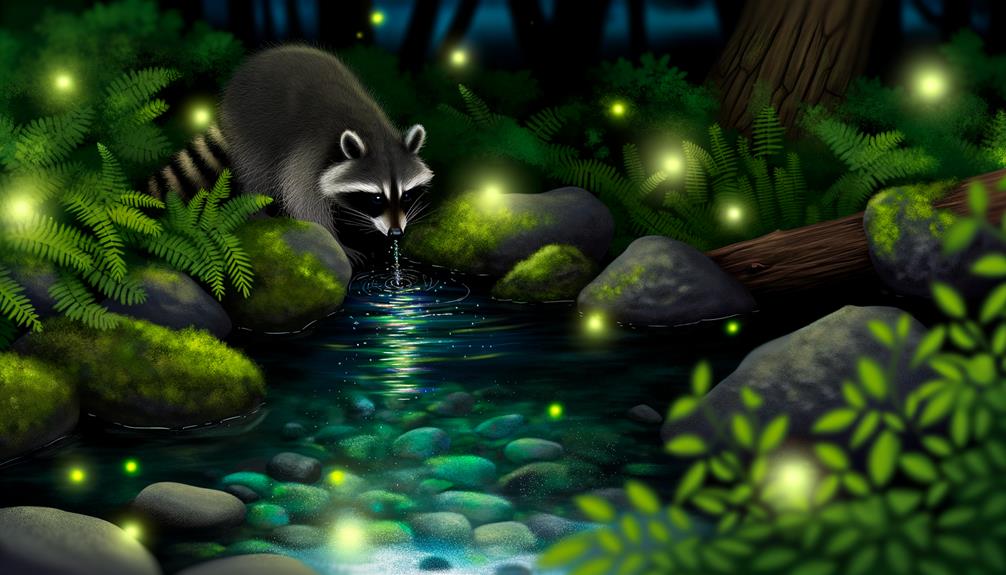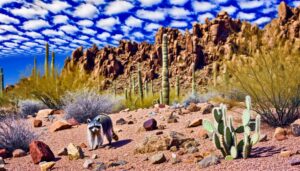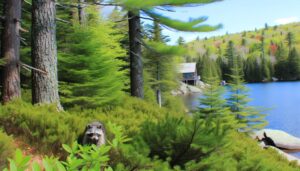How Do Raccoons Get Water in the Wild?
Raccoons obtain water from a range of sources in both urban and natural environments. In the wild, they rely on streams, rivers, ponds, and lakes, with their keen sense of smell and tactile dexterity aiding in location.
Urban raccoons often exploit anthropogenic sources such as pet bowls, bird baths, and swimming pools. They also drink rainwater collected in puddles, leaves, and tree hollows, and consume moisture-rich foods like fruits, insects, and amphibians for hydration.
This multifaceted approach highlights their adaptability and resourcefulness. Understanding their methods can provide deeper insights into their survival strategies.

Key Takeaways
- Raccoons locate natural water sources like streams, rivers, ponds, and lakes using their keen sense of smell.
- They access urban water supplies such as pet bowls and swimming pools, leveraging their nocturnal habits to avoid human activity.
- Raccoons drink from ponds, preferring still or slow-moving water for safety and ease.
- They utilize bird baths in urban areas, visiting them nocturnally to avoid human interference.
- Raccoons consume moisture-rich foods like fruits, amphibians, and insects to meet their hydration needs.
Natural Water Sources
Raccoons primarily obtain water from natural sources such as streams, rivers, ponds, and lakes, which they access through their keen sense of smell and exploratory behavior. These mammals exhibit remarkable adaptability in locating water bodies, often traveling significant distances to find reliable sources.
Their robust olfactory senses enable them to detect the scent of water, while their dexterous forepaws facilitate the examination of potential drinking sites. Observations indicate that raccoons prefer still or gently flowing waters, which offer safer drinking conditions compared to fast-moving streams.
Additionally, their nocturnal habits afford them the advantage of accessing water under the cover of darkness, reducing predation risks. This natural water-seeking behavior underscores raccoons' resilience and resourcefulness in diverse habitats.
Urban Water Supplies
In urban environments, these adaptable mammals often obtain water from anthropogenic sources such as pet bowls, bird baths, swimming pools, and even leaky faucets. Raccoons exhibit remarkable resourcefulness in exploiting human-provided water supplies. Their nocturnal habits facilitate access to these sources when human activity is minimal.
Observations have documented raccoons deftly maneuvering through urban landscapes, demonstrating significant cognitive skills in locating and utilizing available water. The reliance on such sources is indicative of their flexibility and survival strategies in densely populated areas.
This behavior underscores the importance of maintaining clean and secure water containers to prevent potential health risks both to wildlife and humans. Understanding these interactions can aid in developing strategies to coexist harmoniously with urban wildlife.
Drinking From Ponds
Beyond urban areas, natural water sources such as ponds play a significant role in the hydration strategy of raccoons, where their keen sense of smell and tactile dexterity allow them to locate and access water efficiently.
Raccoons are frequently observed near ponds, especially during dawn and dusk when they are most active. Their behavior includes using their sensitive front paws to explore the water, often feeling for food while simultaneously quenching their thirst. This dual-purpose activity highlights their adaptability and resourcefulness.
Observations indicate that raccoons prefer still or slow-moving water, which is abundant in ponds, minimizing the risk of predation and providing a reliable hydration source. This behavior underscores the importance of pond ecosystems in supporting raccoon populations.
Using Bird Baths
Urban environments often provide raccoons with alternative water sources, such as bird baths, which become frequent hydration sites especially during dry periods. These small, elevated pools offer easily accessible water that raccoons can locate through their keen sense of smell.
Observations indicate that raccoons habitually visit bird baths during nocturnal hours to avoid human activity, minimizing conflict. The design of bird baths, often shallow and stable, allows raccoons to drink efficiently without the need for complex physical maneuvers.
Moreover, the consistency of water availability in bird baths, maintained by conscientious homeowners, plays an essential role in supporting urban wildlife. This interaction underscores the importance of understanding and accommodating the needs of local fauna within urban planning and community efforts.
Accessing Rainwater
Raccoons access rainwater through natural collection methods such as puddles and water accumulated on leaves. In urban environments, they utilize resources like gutters, storm drains, and containers left outdoors.
The seasonal availability of rainwater greatly influences their hydration strategies, particularly during dry periods when natural sources are scarce.
Collecting Rainwater Naturally
In their natural habitats, raccoons frequently access rainwater collected in tree hollows, leaves, and other natural depressions. These arboreal and terrestrial reservoirs are essential in providing hydration, especially during dry spells.
Observational data indicates that raccoons exhibit an adeptness at locating these micro-water sources, often seen drinking from leaf axils or concavities formed by fallen logs. Their keen sense of smell aids them in detecting moisture, while their nimble paws facilitate efficient water collection. This behavior underscores the raccoon's adaptability and resourcefulness in utilizing available natural resources.
For wildlife conservationists and ecologists, understanding these water acquisition strategies is important for ensuring the preservation of raccoon habitats, particularly in areas affected by climate change or deforestation.
Utilizing Urban Resources
Amidst urban environments, raccoons have demonstrated remarkable ingenuity in accessing rainwater from various man-made structures such as gutters, downspouts, and drainage systems. These clever mammals exploit the architectural features of buildings to their advantage.
For instance, raccoons climb downspouts to reach accumulated water or drink directly from rainwater that collects in gutters. Additionally, drainage systems, often found in streets and parking lots, provide accessible water sources during rainfall.
Their ability to adapt to urban infrastructure underscores their resourcefulness in securing essential hydration. By leveraging these readily available resources, raccoons not only ensure their survival but also highlight the intricate interactions between wildlife and urban settings, offering an insightful perspective on species adaptability within human-modified landscapes.
Seasonal Water Availability
The adaptability of raccoons extends beyond urban environments to their strategies for accessing rainwater. This ability varies greatly with seasonal changes. During spring and summer, raccoons often find ample water from frequent rain showers. They collect it from natural depressions, tree hollows, and leaf litter. Observations have shown that these mammals are adept at locating temporary puddles and streams that form after rainfall.
In contrast, during autumn and winter, their reliance on rainwater becomes more challenging due to reduced precipitation. Raccoons adjust by utilizing frozen ponds and streams. They break through ice layers to access liquid water beneath. This seasonal adaptability highlights their resilience and resourcefulness, ensuring survival through fluctuating environmental conditions.
Understanding these behaviors aids in wildlife conservation and habitat management efforts.
Scavenging for Liquids
When exploring their environment, raccoons often scavenge for various sources of liquids to stay hydrated, frequently turning to natural water bodies, leftover beverages, and moisture-rich foods.
These adaptable creatures exhibit remarkable resourcefulness, locating water in streams, ponds, and even puddles formed by recent rainfall. Additionally, raccoons are known to investigate human habitats, scavenging for discarded drinks and other liquid-rich residues. Their keen sense of smell aids in detecting these hydration sources.
Observations reveal that raccoons will tip over containers to access trapped water, showcasing their problem-solving abilities. This behavior underscores the raccoon's adaptive strategies in diverse environments, ensuring their survival even in less hospitable conditions.
Their scavenging habits highlight their ecological versatility and resilience.
Water From Food
Raccoons obtain significant hydration from their diet, consuming moisture-laden foods such as fruits, vegetables, insects, and small aquatic animals. This diverse diet provides not only essential nutrients but also a substantial amount of water. For instance, fruits like berries and melons contain high water content, aiding in hydration.
Additionally, raccoons often consume amphibians and crustaceans, which are naturally rich in moisture. Insects, while less water-dense, also contribute to their hydration needs. This dietary behavior allows raccoons to thrive in various environments, even those where direct water sources are scarce.
Conclusion
In the intricate tapestry of raccoon survival, water acquisition emerges as a multifaceted endeavor. From pristine natural springs to the artful utilization of urban bird baths, each method exemplifies their adaptive ingenuity.
Rainwater serves as nature's elixir, while scavenging and moisture-rich foods further quench their thirst. This mosaic of strategies underscores the raccoon's resilience and resourcefulness in maneuvering their hydrological needs, painting a vivid picture of their relentless pursuit of life-sustaining hydration.






